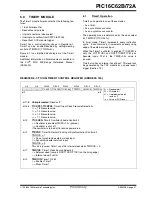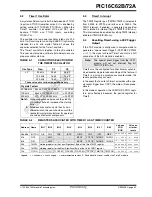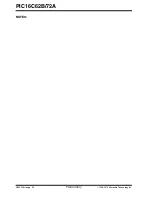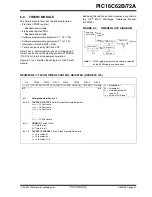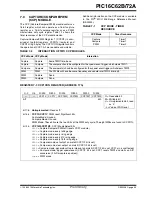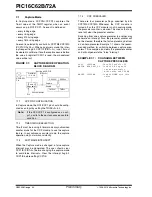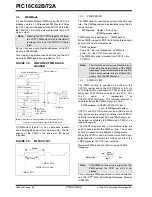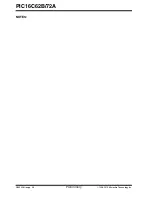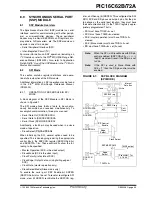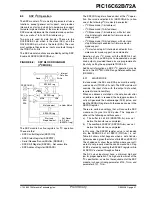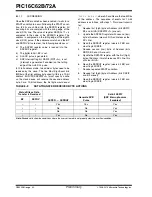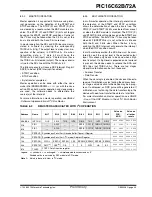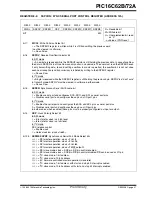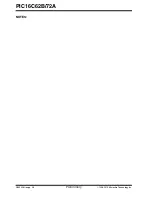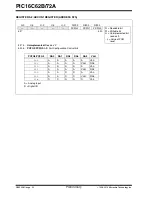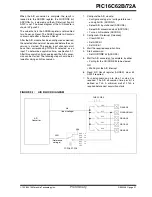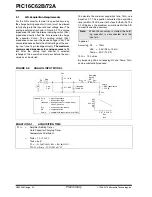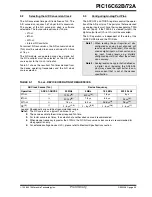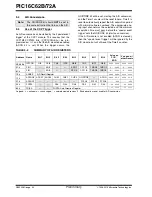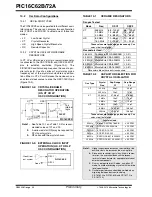
PIC16C62B/72A
1998-2013 Microchip Technology Inc.
Preliminary
DS35008C-page 41
8.3
SSP I
2
C Operation
The SSP module in I
2
C mode fully implements all slave
functions, except general call support, and provides
interrupts on start and stop bits in hardware to support
firmware implementations of the master functions. The
SSP module implements the standard mode specifica-
tions, as well as 7-bit and 10-bit addressing.
Two pins are used for data transfer. These are the
RC3/SCK/SCL pin, which is the clock (SCL), and the
RC4/SDI/SDA pin, which is the data (SDA). The user
must configure these pins as inputs or outputs through
the TRISC<4:3> bits.
The SSP module functions are enabled by setting SSP
Enable bit SSPEN (SSPCON<5>).
FIGURE 8-2:
SSP BLOCK DIAGRAM
(I
2
C MODE)
The SSP module has five registers for I
2
C operation.
These are the:
• SSP Control Register (SSPCON)
• SSP Status Register (SSPSTAT)
• Serial Receive/Transmit Buffer (SSPBUF)
• SSP Shift Register (SSPSR) - Not accessible
• SSP Address Register (SSPADD)
The SSPCON register allows control of the I
2
C opera-
tion. Four mode selection bits (SSPCON<3:0>) allow
one of the following I
2
C modes to be selected:
• I
2
C Slave mode (7-bit address)
• I
2
C Slave mode (10-bit address)
• I
2
C Slave mode (7-bit address), with start and
stop bit interrupts enabled for firmware master
mode support
• I
2
C Slave mode (10-bit address), with start and
stop bit interrupts enabled for firmware master
mode support
• I
2
C start and stop bit interrupts enabled for firm-
ware master mode support, slave mode idle
Selection of any I
2
C mode, with the SSPEN bit set,
forces the SCL and SDA pins to be operated as open
drain outputs, provided these pins are programmed to
inputs by setting the appropriate TRISC bits.
Additional information on SSP I
2
C operation may be
found in the PIC
®
MCU Mid-Range Reference Manual,
(DS33023).
8.3.1
SLAVE MODE
In slave mode, the SCL and SDA pins must be config-
ured as inputs (TRISC<4:3> set). The SSP module will
override the input state with the output data when
required (slave-transmitter).
When an address is matched or the data transfer after
an address match is received, the hardware automati-
cally will generate the acknowledge (ACK) pulse, and
load the SSPBUF register with the received value in the
SSPSR register.
There are certain conditions that will cause the SSP
module not to give this ACK pulse. This happens if
either of the following conditions occur:
a)
The buffer full bit BF (SSPSTAT<0>) was set
before the transfer was completed.
b)
The overflow bit SSPOV (SSPCON<6>) was set
before the transfer was completed.
In this case, the SSPSR register value is not loaded
into the SSPBUF, but bit SSPIF (PIR1<3>) is set.
Table 8-2 shows what happens when a data transfer
byte is received, given the status of bits BF and SSPOV.
The shaded cells show the condition where user soft-
ware did not properly clear the overflow condition. Flag
bit BF is cleared by reading the SSPBUF register, while
bit SSPOV is cleared through software.
The SCL clock input must have a minimum high and
low for proper operation. The high and low times of the
I
2
C specification, as well as the requirement of the SSP
module, is shown in timing parameter #100, T
HIGH
, and
parameter #101, T
LOW
.
Read
Write
SSPSR reg
Match detect
SSPADD reg
Start and
Stop bit detect
SSPBUF reg
Internal
Data Bus
Addr Match
Set, Reset
S, P bits
(SSPSTAT reg)
RC3/SCK/SCL
RC4/
shift
clock
MSb
SDI/
LSb
SDA
Summary of Contents for PIC16C62B/72A
Page 4: ...PIC16C62B 72A DS35008C page 4 Preliminary 1998 2013 Microchip Technology Inc NOTES...
Page 30: ...PIC16C62B 72A DS35008C page 30 Preliminary 1998 2013 Microchip Technology Inc NOTES...
Page 38: ...PIC16C62B 72A DS35008C page 38 Preliminary 1998 2013 Microchip Technology Inc NOTES...
Page 48: ...PIC16C62B 72A DS35008C page 48 Preliminary 1998 2013 Microchip Technology Inc NOTES...
Page 80: ...PIC16C62B 72A DS35008C page 80 Preliminary 1998 2013 Microchip Technology Inc NOTES...
Page 104: ...PIC16C62B 72A DS35008C page 104 Preliminary 1998 2013 Microchip Technology Inc NOTES...
Page 110: ...PIC16C62B 72A DS35008C page 110 Preliminary 1998 2013 Microchip Technology Inc NOTES...
Page 120: ...PIC16C62B 72A DS35008C page 120 Preliminary 1913 Microchip Technology Inc...

